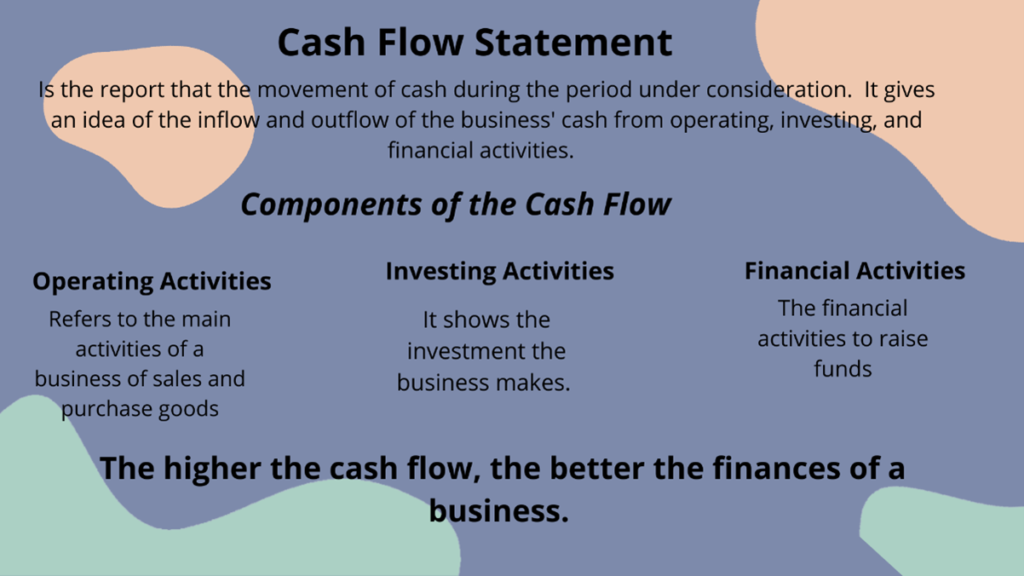What is a Cash Flow Statement?

A Cash Flow Statement, also called a Statement of Cash Flows, is one of the most important financial statements businesses use to determine how well they are doing financially. It gives a company’s cash inflows and losses in great depth for a certain period, usually a fiscal quarter or year.
There are three main parts to the Cash Flow Statement:
- Operating Activities: This part shows cash coming into and leaving the company due to its main business activities, such as selling goods and services and cash payments to sellers and workers.
- Investing Activities: This part shows cash flows from buying and selling long-term assets like land, plant, and equipment, as well as financial instruments. For example, this would include money from the sale of a plant or money spent on buying tools.
- Financing Activities: This part describes the cash transactions that the company’s owners and customers make, such as releasing stock, paying bonuses, borrowing money, or paying back loans.
The Cash Flow Statement is very important for understanding a company’s finances and ability to pay its bills because it shows how it makes money to pay for its operations and growth and how it spends that money. The statement lets investors, creditors, and others know how well the company can make money, pay back its bills, pay bonuses, and invest in new possibilities.
What to Include in the Cash Flow Statement?
To do a cash flow analysis, you need to prepare your cash flow statement, which shows the cash movement during a specific period of time.

Examples of Cash Flow
Please note, this is a simplified and hypothetical example. In reality, the cash flow statement would contain more detail and complexity, including various categories of expenses and income, depending on the business’s activities.
Fashion House Inc.
Statement of Cash Flows
For the Year Ended December 31, 2023
All figures are in thousands of dollars.
Cash Flows from Operating Activities:
Net Sales: $2,000
Cost of Goods Sold: (-$800)
Operating Expenses:
- Salaries and Wages: (-$300)
- Rent: (-$100)
- Utilities: (-$50)
- Marketing & Advertising: (-$50)
Increase in Inventory: (-$100)
Increase in Accounts Receivable: (-$150)
Increase in Accounts Payable: $100
Depreciation & Amortization: (-$50)
Income Taxes Paid: (-$100)
Net Cash Provided by Operating Activities: $400
Cash Flows from Investing Activities:
Purchase of New Equipment: (-$200)
Improvements to Property (Leasehold Improvements): (-$50)
Proceeds from Sale of Old Equipment: $25
Net Cash Used in Investing Activities: (-$225)
Cash Flows from Financing Activities:
Issuance of Common Stock: $0 (Assuming no new stock issuance)
Payment of Dividends: (-$100)
Repayment of Long-Term Debt: (-$50)
Proceeds from New Long-Term Debt: $200
Net Cash Provided by Financing Activities: $50
Net Increase in Cash: $225
Cash at the beginning of the period: $300
Cash at the end of the period: $525
In this detailed scenario, operating activities generated $400k in cash, with numerous expenses such as salaries, rent, utilities, marketing, inventory changes, increases in accounts receivable, and income taxes all considered.
Investing activities consumed $225k due to purchasing new equipment and improvements to the store property. Some cash was recouped from selling old equipment.
Financing activities, including dividend payments, debt repayment, and proceeds from new debt, resulted in a net cash inflow of $50k.
Overall, the store increased its cash position by $225k during the year, starting with $300k and ending with $525k.
Cash Flows
Cash Flows from Operating Activities: This part does show how much cash a company’s main business activities bring in or take out. It usually includes cash from sales of goods and services, cash paid to sellers and workers, interest collected or paid, and taxes paid. This part is important because it shows how much money the business makes from its main tasks, which should be the major source of long-term positive cash flow.
Cash Flows from Investing Activities: This part of the statement shows cash flows linked to the purchase or sale of long-term assets, like land, plant, and equipment, and investments in other businesses, like buying or selling partner companies or investment stocks. This part shows how much money the company is putting back into itself or into other businesses. Large negative cash flows can be a good sign if it means the company is investing in its future growth. However, it could also be a sign of trouble if the company sells its long-term assets to get cash.
Cash Flows from Financing Activities: Here, you’ll find cash flows related to how the company deals with its owners and debtors. This includes giving out or buying back shares, giving out or paying back loans, and giving out profits. Positive cash flows in this area could mean that the company is taking on debt or selling shares to get cash, while negative cash flows could mean that the company is paying off debt, buying back shares, or giving profits to owners (for example, through bonuses).
Together, these three parts give a full picture of where the company’s cash comes from and where it goes. This can tell you a lot about how the company is doing now and its future plans.
Main Aspects You Need To Know About Cash Flow
Cash flow management is important for all businesses, but it’s especially important for startups, which often run in markets that aren’t clear and can have big upfront costs with no way to pay them right away. Here are some important things that both new and old businesses should think about when it comes to cash flow:
- Cash Flow vs. Profit: It is very important to know how cash flow differs from profit. A company may show a profit on the income sheet, but if its cash losses are more than its cash inflows, it can quickly get into financial problems.
- Cash Flow Forecasting is the process of figuring out how much money will come into and leave a business over a certain time frame. It can help businesses figure out where they might be short or have too much money and plan their actions around that.
- Operating Cash Flow: This shows how much cash the business makes from its core operations but not from investing or financing. Positive working cash flow means that a company can make enough money from how it runs its business to keep it going and grow it.
- Cash Flow from Investing Activities: This includes buying and selling long-term assets like land, tools, or stakes in other businesses. Startups often have big cash losses in this area because they have to spend a lot of money on getting started and growing.
- Cash Flow from Financing: This includes getting money from investors (either through loans or stock), paying it back, and giving out rewards. For their early growth, startups often depend heavily on funding efforts.
- Cash Burn Rate: The cash burn rate is the rate at which a company spends its capital until it starts making money. This is especially important for new businesses. The longer a company can stay in business without getting more money, the lower its burn rate.
- Cash Runway: This is linked to the burn rate and is the amount of time a company can keep running with the cash it has on hand.
- Working Capital Management is handling a company’s short-term assets (like accounts received and goods) and liabilities (like accounts due) to ensure it has enough cash to keep running and pay its debts.
- Plan B: Planning unplanned events affecting your cash flow can save your life. This could mean getting lines of credit or finding things that aren’t very important but could be sold in a pinch.
- Cash Flow Statement Analysis: Knowing how to evaluate a cash flow statement can help a business determine how flexible it is, how well it runs, and how stable its finances are. The cash flow percentage, the working cash flow ratio, and the free cash flow are all important measures.
By taking care of these parts of cash flow well, a business can keep its finances in good shape and achieve long-term success.


